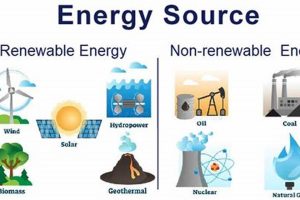
The classification of wood as an energy source hinges on a crucial distinction: the balance between consumption and replenishment. If wood is harvested at a rate that forests can naturally replace it... Read more »

Electricity generated from the energy of moving water is generally considered a sustainable energy source. Harnessing this power typically involves constructing dams and reservoirs to control water flow and drive turbines. For... Read more »

Heat derived from the Earth’s subsurface can be harnessed as a power source. This thermal energy originates from the planet’s formation and the decay of radioactive elements within its core. Accessing this... Read more »

Resources derived from ancient organic matter, like petroleum, coal, and natural gas, are finite. Their formation takes millions of years under specific geological conditions, a timescale incompatible with human consumption rates. For... Read more »

Nuclear fission relies on the splitting of atoms of heavy elements like uranium, a finite resource extracted from the Earth. This process releases tremendous energy, but the uranium ore itself is not... Read more »

Energy resources are broadly categorized based on their replenishment rate. Resources that naturally replenish over a relatively short period are considered sustainable. These sources include solar, wind, hydro, geothermal, and biomass energy.... Read more »

Natural resources are categorized based on their replenishment rates. Resources that can be replenished naturally over a relatively short period, often within a human lifespan, are considered sustainable. Examples include solar energy,... Read more »

Hydrogen’s classification as a renewable or nonrenewable energy source depends entirely on its production method. Electrolysis powered by renewable sources like solar or wind creates green hydrogen, a truly renewable fuel. However,... Read more »

The categorization of energy sources as renewable or nonrenewable hinges on whether they are naturally replenished within a human timescale. Harnessing the predictable rise and fall of ocean tides generates power. This... Read more »



